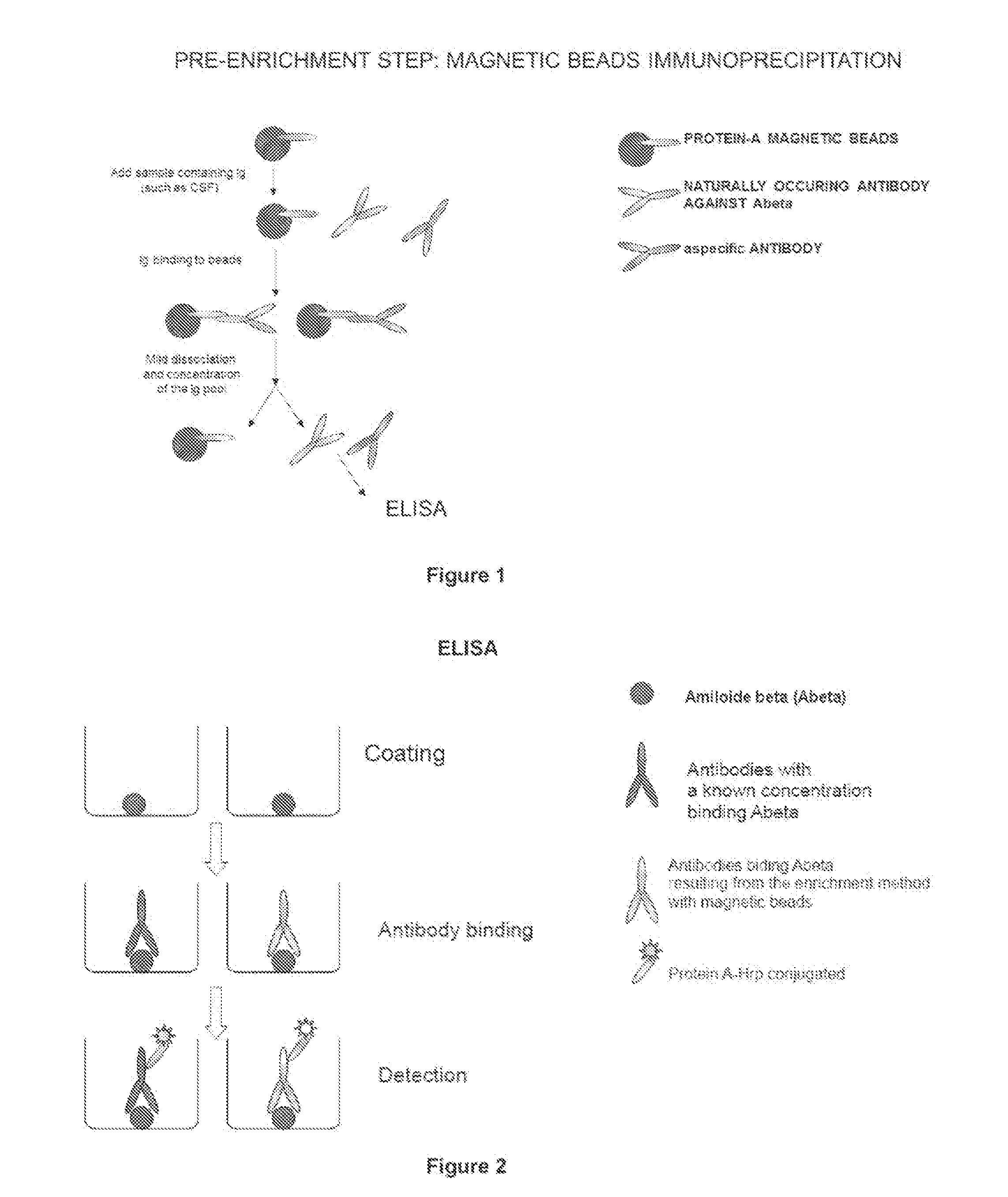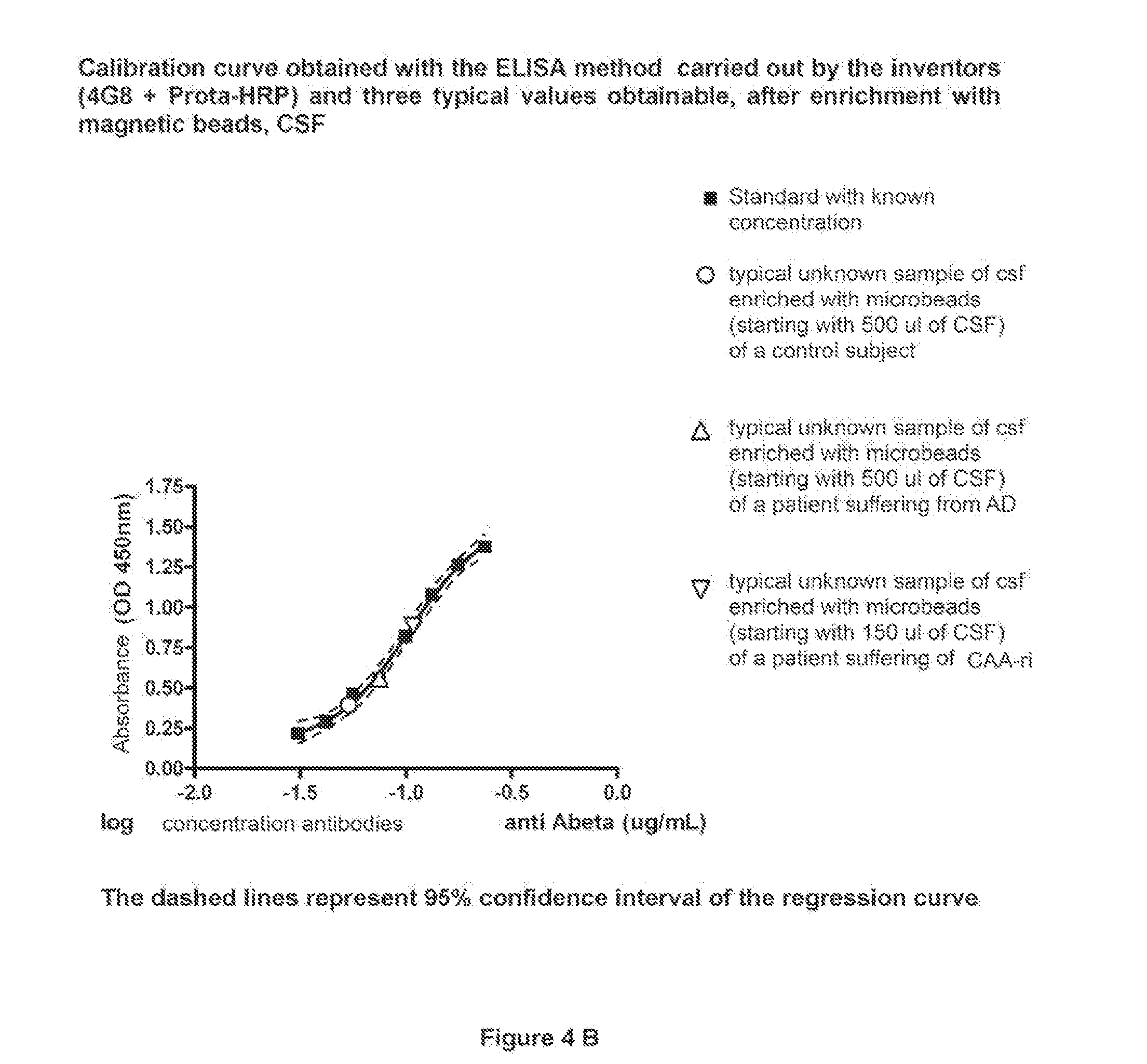Method and kit for detection of Anti-beta amyloid antibodies
- Summary
- Abstract
- Description
- Claims
- Application Information
AI Technical Summary
Benefits of technology
Problems solved by technology
Method used
Image
Examples
example 1
Procedure for Concentrating with Magnetic Micro Beads
[0156]1) Wash twice with PBS. pH 7.4, +0.02% Tween, 75 μl of magnetic micro beads conjugated to protein A (Invitrogen Dynal AS Dynabeads® protein G) for each sample to be analysed;
[0157]2) add to the washed magnetic micro beads a sample volume comprised between 200 and 500 μl of CSF from a patient and incubate under stirring for 40 min. at room temperature;
[0158]3) place the magnetic micro beads in the magnet for 2 min.; optionally store supernatant in another test tube (it will act as control for process efficiency);
[0159]4) remove from magnet and wash with 500 μl of citrate-phosphate buffer, pH 5+0.02% Tween, repeat twice;
[0160]5) then proceed with the elution phase, by adding 30 μl of 0.1 M citrate at pH 3.1 to the magnetic micro beads;
[0161]6) stir for 2 min;
[0162]7) place the tube in the magnet for 1 min and immediately transfer supernatant in a clean test tube (Eppeodorf polypropylene low affinity tube) containing 40 μl of 1...
example 2
Coating the Microplate with Abeta42 Protein
[0165]1) dissolve Abeta42 protein in 1M Tris Base buffer, pH 9, to a concentration of 1 μg / μl;
[0166]2) prepare a coating solution of Abeta in 50 mM NaHCO3, pH 9.6, to a concentration of 0.01 μg / μl;
[0167]3) sonicate for 1 min on ice, wait 1 min, sonicate again for 1 min;
[0168]4) add 100 μl of a coating solution per ELISA plate well (end concentration: 1 μg / μl);
[0169]5) incubate overnight
example 3
Immunoenzymatic Dosage
[0170]1) on the day following the coating performed as described in example 2, carry out 3 washings with PBS+0.05% Tween (PBST), 200 μl / well;
[0171]2) perform blocking to exclude a specific binding, by using a solution comprised of 5% serum and 1%BSA in PBST, 1.5 h at room temperature under oscillation;
[0172]3) repeat, the washing step described at 1);
[0173]4) add 100 μl of the solution containing the primary antibody 4G8 (directed toward the amino acid portion 17-24 of the Abeta protein), to construct the standard curve. Standards are carded out by serial dilutions of the primary antibody. The range suggested for the standard curve for antibodies dosage in the CSF is of from 0.24 to 0.03 μg / ml. In walls to be used as blank, add only 100 μl of PBS. Moreover, a further blank for eluates is provided, comprised of 60 μl of 0.1 M citrate, pH 3.1, plus 40 μl of 1M Tris Base, pH 9.
[0174]5) add 100 μl of the sample of CSF as concentrated in Example 1 into the wells. Le...
PUM
| Property | Measurement | Unit |
|---|---|---|
| Density | aaaaa | aaaaa |
| Density | aaaaa | aaaaa |
| Density | aaaaa | aaaaa |
Abstract
Description
Claims
Application Information
 Login to View More
Login to View More - R&D
- Intellectual Property
- Life Sciences
- Materials
- Tech Scout
- Unparalleled Data Quality
- Higher Quality Content
- 60% Fewer Hallucinations
Browse by: Latest US Patents, China's latest patents, Technical Efficacy Thesaurus, Application Domain, Technology Topic, Popular Technical Reports.
© 2025 PatSnap. All rights reserved.Legal|Privacy policy|Modern Slavery Act Transparency Statement|Sitemap|About US| Contact US: help@patsnap.com



